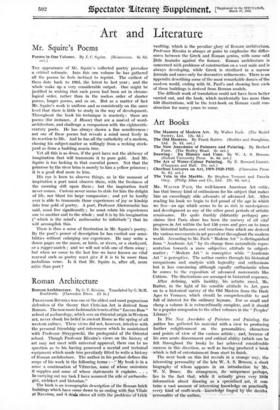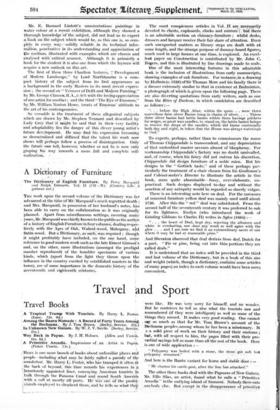Art Books
The New Anecdotes of Painters and Painting. By Herbert Furst. (The Bodley Head. 6s. net.)
The Art of Water-Colour Painting. By E. Barnard-Lintott. (Chapman and Hall. 21s. net.)
The Vein in the Marble. By Stephen Tennant and Pamela Grey. (Philip Allan and Co., Ltd. 12s. 6d. net.) MR. WALTER PAcn, . the well-known American Art critic, has that breezy kind of enthusiasm for his subject that makes
him an exceedingly able advocate of advanced Art. After reading his book we begin to feel proud of the age in which we live—an age which seems to be as rich in masterpieces and development as any of the ether great periods of artistic
renaissance. He quite frankly (blatantly perhapS) pro- claims that Paris alone has been the _nursery of all vital prouress -in Art within the last 150 years and goes on to trace the historicalinfluences and reactions from which are derived
the various movements in art prevalent throughout the modern world. According to Mr. Paeh " Modern Art " is distinguished from 'Academic Art " by its change from naturalistic repre- sentation towards a more subjective attitude to subject- matter ; " Modem Art " is conceptive while " Academic Art " is perceptive. The author carries through his historical CompariSons and analysis with logicality and enthusiasm but is less convincing although . equally enthusiastic when he comes to _the • exposition of advanced movements like Cubism. The illustrations are arranged in historical sequence.
After defining, with lucidity, his artistic creed, Mr.
Rutter, in the light of his sensible attitude to Art, goes on to a historical survey of the Old Masters from the Dark Ages to Vermeer, which should be comprehensible to and
full of-interest for the ordinary layman. For so small and
cheap a volume it is extraordinarily complete, and it should be a popular companion to the other volumes in the " Peoples' Library."
In The New Anecdotes of Painters and Painting, the _author has gathered his material with a view to producing
further enlightenment on the personalities, characters Nand points of view of the various artists ; and, because of his own acute discernment and critical ability (which can be
felt throughout the book) he hai achieved considerable -isuecess in this direction, as well -as having produced a book -which is full of entertainment from start to finish.
The next book on this list reveals in a strange way, the interesting personality of the late W. A. S. Benson, a short biography of whom appears in an introduction by Mr.
W. N. Bruce. Its strangeness, its uniqueness perhaps, lies in the fact that, while it actually . gives, very little information about 'drawing as a specialized ,art, it con.
tains a vast amount of interesting knowledge on practieall3 every kind of craft-work—knowledge tinged by the decider personality of the author. -
Mr. K Barnard Lintott's unostentatious paintings in water colour at a recent exhibition, although they showed a thorough knowledge `Of the subject, did not. lead.. us to expect on the subject which would be, as this one is, so com- plete in every_ way—solidly. reliable. in its technioal infor- riaiion, penetrative in its understanding and appreciation of the medium, illustrated with examples which are chosen and analysed ivitlicritieal acumen. Although it is primarily a book for the student it is also one from which the layman will acquire a new outlook on this art.
The first of these three Charlton lectures, Development of Modern Landscape," by Lord Nerthbourne is a com- pact history of the subject from its first appearance as a background in the early Masters to its moat-recent expres- sion ; the second on " Vermeer of Delft and Modern Painting," by Mr. George Clausen, R.A., is felt with the loving appreciation of one artist for another; and the third `The Eye of Erasmus," by Mr. William Norton Howe, treats of -Erasmus' attitude to the art of his contemporaries.
So versatile is the treatment of these allegorical subjects which are drawn by Mr. Stephen Tennant and described by Lady Grey that' it might be said that in their very facility and adaptability lies the danger of this clever young artist's future deVelopment. He may find his expression becoming so decentralized and diffused that the talent his work now shows will 'Perhaps follow a process of disintegration. Only the future-can-tell, however, whether or not he is now only groping his way towards a more.. full and complete self- realization. -























































 Previous page
Previous page